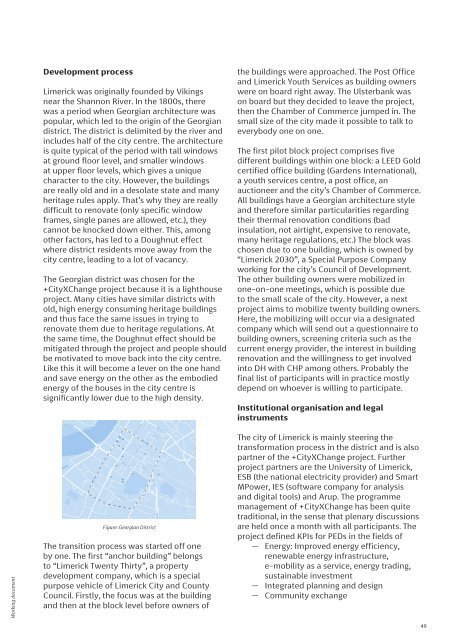Cities4PEDs Atlas_November 2021.pdf
Atlas - From 7 case interviews to recurring strategies and PED relevant aspects
Atlas - From 7 case interviews to recurring strategies and PED relevant aspects
- No tags were found...
You also want an ePaper? Increase the reach of your titles
YUMPU automatically turns print PDFs into web optimized ePapers that Google loves.
Development process<br />
Limerick was originally founded by Vikings<br />
near the Shannon River. In the 1800s, there<br />
was a period when Georgian architecture was<br />
popular, which led to the origin of the Georgian<br />
district. The district is delimited by the river and<br />
includes half of the city centre. The architecture<br />
is quite typical of the period with tall windows<br />
at ground floor level, and smaller windows<br />
at upper floor levels, which gives a unique<br />
character to the city. However, the buildings<br />
are really old and in a desolate state and many<br />
heritage rules apply. That’s why they are really<br />
difficult to renovate (only specific window<br />
frames, single panes are allowed, etc.), they<br />
cannot be knocked down either. This, among<br />
other factors, has led to a Doughnut effect<br />
where district residents move away from the<br />
city centre, leading to a lot of vacancy.<br />
The Georgian district was chosen for the<br />
+CityXChange project because it is a lighthouse<br />
project. Many cities have similar districts with<br />
old, high energy consuming heritage buildings<br />
and thus face the same issues in trying to<br />
renovate them due to heritage regulations. At<br />
the same time, the Doughnut effect should be<br />
mitigated through the project and people should<br />
be motivated to move back into the city centre.<br />
Like this it will become a lever on the one hand<br />
and save energy on the other as the embodied<br />
energy of the houses in the city centre is<br />
significantly lower due to the high density.<br />
the buildings were approached. The Post Office<br />
and Limerick Youth Services as building owners<br />
were on board right away. The Ulsterbank was<br />
on board but they decided to leave the project,<br />
then the Chamber of Commerce jumped in. The<br />
small size of the city made it possible to talk to<br />
everybody one on one.<br />
The first pilot block project comprises five<br />
different buildings within one block: a LEED Gold<br />
certified office building (Gardens International),<br />
a youth services centre, a post office, an<br />
auctioneer and the city’s Chamber of Commerce.<br />
All buildings have a Georgian architecture style<br />
and therefore similar particularities regarding<br />
their thermal renovation conditions (bad<br />
insulation, not airtight, expensive to renovate,<br />
many heritage regulations, etc.) The block was<br />
chosen due to one building, which is owned by<br />
“Limerick 2030”, a Special Purpose Company<br />
working for the city’s Council of Development.<br />
The other building owners were mobilized in<br />
one-on-one meetings, which is possible due<br />
to the small scale of the city. However, a next<br />
project aims to mobilize twenty building owners.<br />
Here, the mobilizing will occur via a designated<br />
company which will send out a questionnaire to<br />
building owners, screening criteria such as the<br />
current energy provider, the interest in building<br />
renovation and the willingness to get involved<br />
into DH with CHP among others. Probably the<br />
final list of participants will in practice mostly<br />
depend on whoever is willing to participate.<br />
Institutional organisation and legal<br />
instruments<br />
Working document<br />
Figure: Georgian District<br />
The transition process was started off one<br />
by one. The first “anchor building” belongs<br />
to “Limerick Twenty Thirty”, a property<br />
development company, which is a special<br />
purpose vehicle of Limerick City and County<br />
Council. Firstly, the focus was at the building<br />
and then at the block level before owners of<br />
The city of Limerick is mainly steering the<br />
transformation process in the district and is also<br />
partner of the +CityXChange project. Further<br />
project partners are the University of Limerick,<br />
ESB (the national electricity provider) and Smart<br />
MPower, IES (software company for analysis<br />
and digital tools) and Arup. The programme<br />
management of +CityXChange has been quite<br />
traditional, in the sense that plenary discussions<br />
are held once a month with all participants. The<br />
project defined KPIs for PEDs in the fields of<br />
— Energy: Improved energy efficiency,<br />
renewable energy infrastructure,<br />
e-mobility as a service, energy trading,<br />
sustainable investment<br />
— Integrated planning and design<br />
— Community exchange<br />
49


















